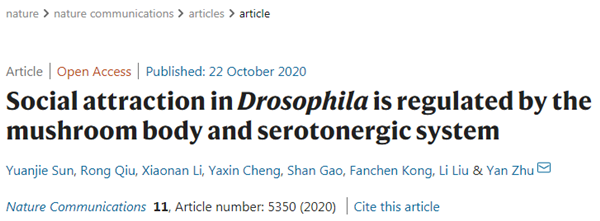Home> News
Researchers reveal mechanism for animals' social attraction
Updated: 2020-10-30

The paper published by the Chinese research group in the journal Nature Communications on Oct 22. [Photo/nature.com]
A research group from the Institutes of Biophysics, at the Chinese Academy of Sciences, recently provided evidence that neurons in the central brain regions of the Drosophila genus of fruit flies regulate the tendency for social affiliation, a prerequisite for advanced social interactions. Its findings were published in a paper in the journal Nature Communications on Oct 22, providing a promising basis for elucidating the neural root of sociality.
Entitled "Social attraction in Drosophila is regulated by the mushroom body and serotonergic system", the paper points out that sociality is among the most important motivators of human behavior. However, the neural mechanisms determining levels of sociality are largely unknown, primarily due to a lack of suitable animal models.
In the paper, researchers reported the presence of a surprising degree of general sociality in Drosophila.
The researchers reported that a newly developed paradigm to study social approach behavior in flies revealed that social cues perceived through both vision and olfaction converged in a central brain region, the γ lobe of the mushroom body, which exhibited activation in response to social experience.
The activity of these γ neurons controls the motivational drive for social interaction. At the molecular level, the serotonergic system is critical for social affinity.
The researchers found that these results demonstrate that Drosophila are highly sociable, providing a suitable model system for elucidating the mechanisms underlying the motivation for sociality.
